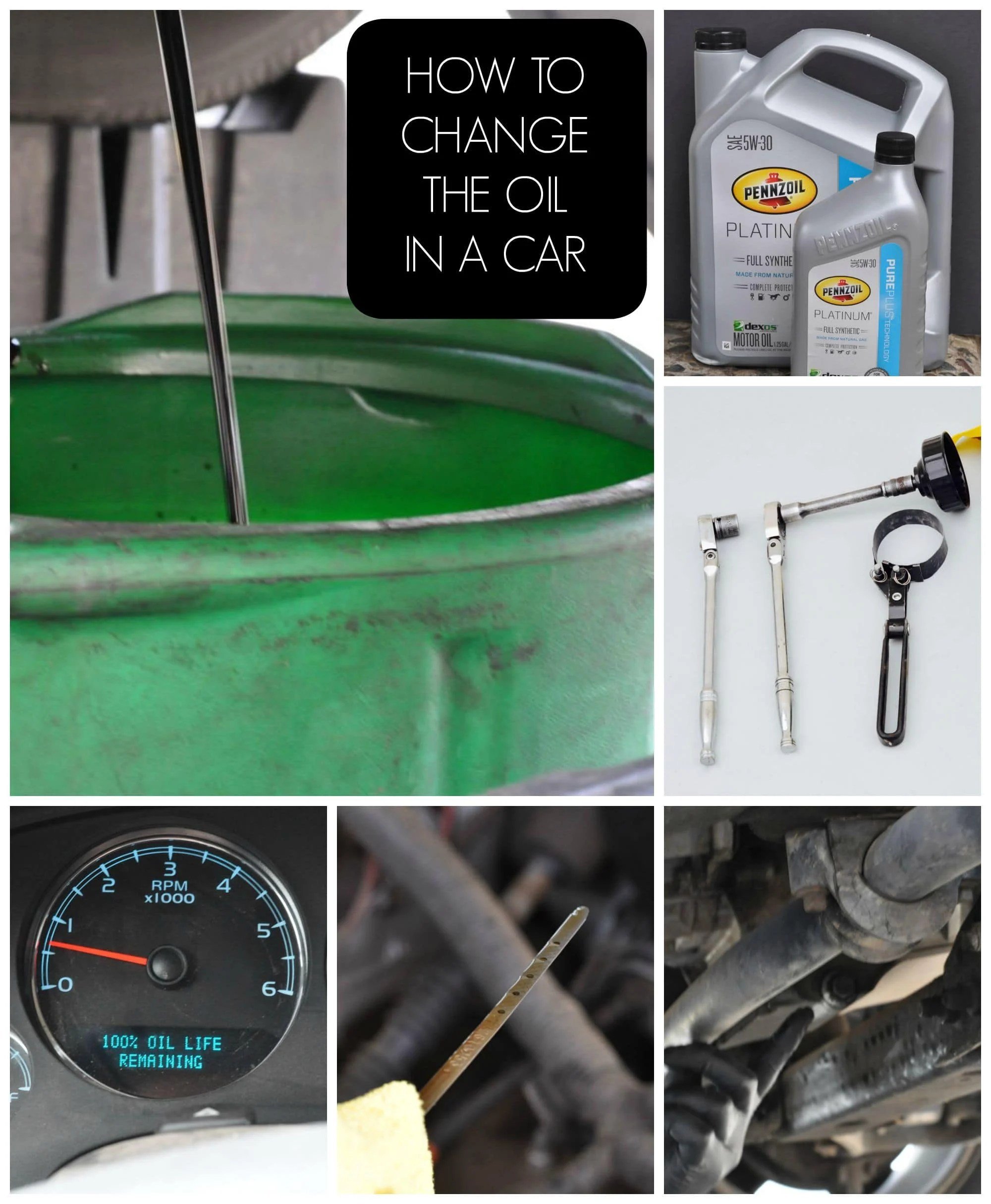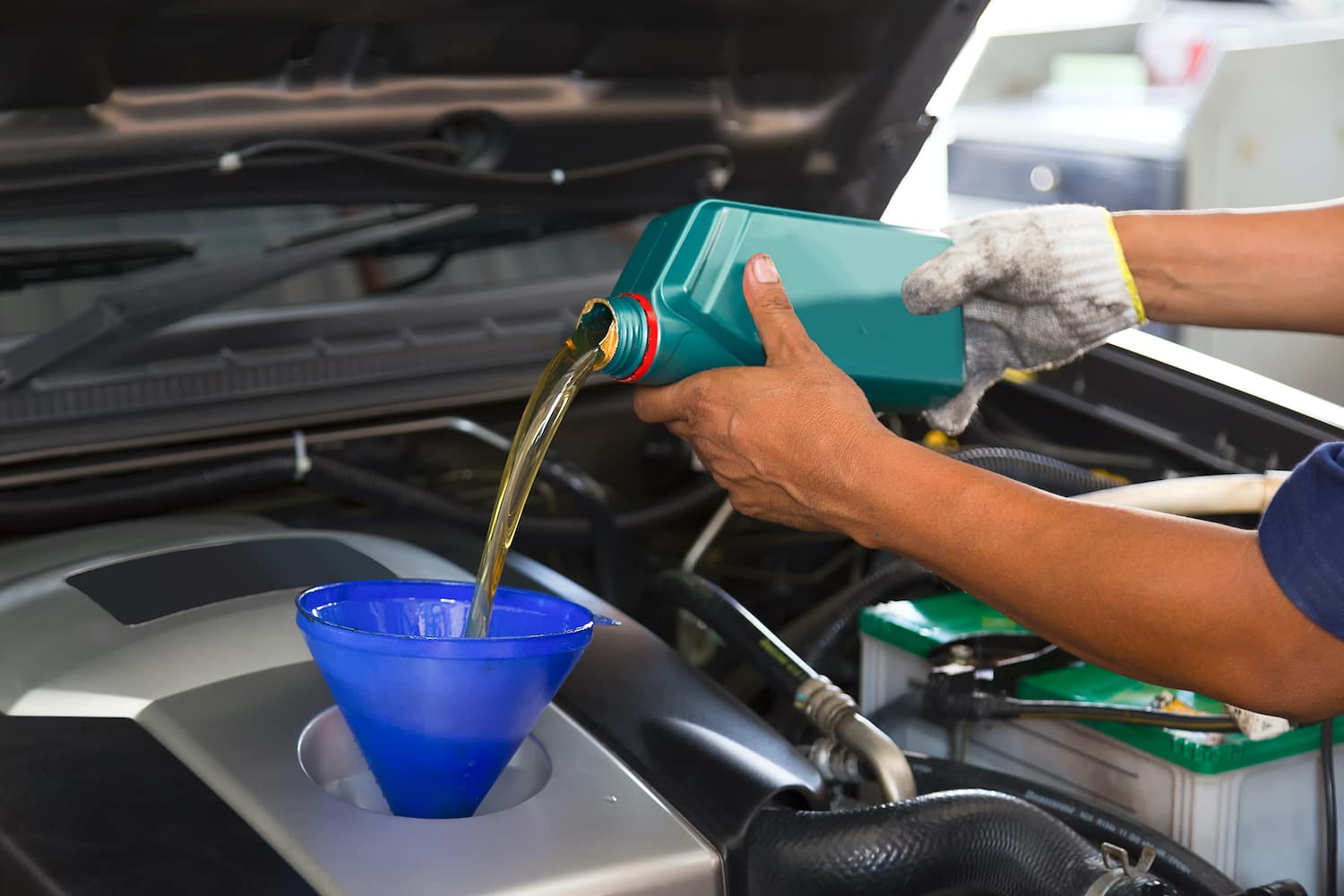What Do The Letters And Numbers On The Oil Can Mean
Specifications such as 10W-40 or 25W-60 are the so-called SAE classes . The number before the W gives information about the flow rate of the oil in cold weather. The smaller the number, the smoother. Behind it is the flow rate at 100 ° C. The lower the numbers, the higher the quality of the oil, because it is more fluid and thus better distributed in the engine. This is referred to as so-called low-viscosity oils.
Engine oils may also be mixed, but only diesel oil with diesel oil or oil for a gasoline engine with oil for a gasoline engine. Many dealers offer additives for the engine oil. However, these are very controversial and lead to void the warranty for most vehicle manufacturers.
When Should You Change Your Oil
Follow this simple guide to keep your engine humming a happy tune.
You know you need to change your car’s oil at some point, but how often? The answer can be confusing, because it varies based on driving conditions and your driving habits. Let us simplify it for you.
Conservative estimates for oil-change intervals used to be as low as 3000 miles, before significant improvements in fuel-delivery systems, engine materials, manufacturing methods, and oil chemistry. Today, modern engines driven normally stretch intervals to 7500 or even more than 10,000 miles. So what’s the right answer?
How Many Miles Can You Drive On Empty
Believe it or not, you can drive as long as you want without oil in your car. When your car engine is turned off and is not running, there is no oil inside of the motor. It results in a lack of lubricant for all of the moving parts of the engine. Yet, because the oil is not where it is supposed to be, you cannot drive your car. Why?
Oil usually stays inside of the engine and does not come out unless there is a problem such as leaking or over-filling which causes oil to spill into other parts of the engine. Most people do not run their cars dry and a certain amount of oil is usually spread across all of the moving parts.
Read Also: Car Salesman Confidential
Log Info Clean Up Recycle Used Oil
Write down your vehicles current mileage and the date. Refer to your vehicles owners manual for the recommended oil change interval , add that number to your vehicles current mileage and change the oil again at the resulting mileage. Carefully dispose of the used oil filter, any used rags, newspaper or paper towels. Put away your tools.
Recycle the used motor oil. Many service stations and quick lubes will accept used motor oil and used oil filters at no charge. Find recycling locations in your area at Earth911.com. Your local government and/or recycling coordinators may be able to tell you which materials can be recycled with your trash pickup.
Ready for your next oil change?
The miles can really add up quickly between oil changes. Bookmark this page and use these step-by-step oil change instructions as general guidelines each time. Refer to your vehicles owners manual for manufacturer-specific oil change instructions, warranty information and more.
Install New Oil Filter

For cartridge-style oil filter Place the new paper filter into the cartridge housing, apply a thin layer of oil to the new O-ring gasket and fit the new O-ring gasket into the groove of the cartridge housing. Install the new oil filter by fitting the oil filter wrench on the new oil filter, slowly turning clockwise to tighten.
For spin-on-style oil filter Apply a thin layer of oil to the new filters O-ring gasket. Install the new filter by hand, slowly turning clockwise to tighten.
Recommended Reading: Carcareone Online Merchants
When Your Vehicle Is In Warranty
When a vehicle is new, the answer is simple: If you don’t want to void your powertrain warranty, follow the oil type, mileage, and time recommendations in the owner’s manual. In most cases, you’ll be taking your vehicle to the dealer for required inspections and maintenance, and oil changes will be included in that regime.
Some newer vehicles have a built-in oil-life monitor. This gadget uses an algorithm, sensors, and software that keep track of drive temperatures, cold starts, driving hours, idling hours, and engine revs. It uses that data to calculate the oil’s condition and warranty-preserving change intervals. Keep in mind that the oil monitor is calibrated for the oil type recommended in the owner’s manual. Service alerts are displayed in the instrument cluster. In some systems, one of the instrument-cluster information screens will read out remaining oil life as a percentage. This is much different from the red oil-pressure warning light that glows when you start the engine. If that’s on while you’re driving or idling, it means you’re out of oil or have a very serious engine issue. Time to park and key off.
How Often Should I Have An Oil Change Done
It depends on the engine and how much you drive. The interval ranges, depending on the make, from 15,000 to 40,000 kilometers. Exact numbers are available in the user manual of your car. Those who drive on average a lot, so 10,000 to 15,000 kilometers per year, about every 1.5 to 2 years before they need to change the oil in a car.
And: The additives wear out even when the engine is only slightly moved. In some on-board computers, there is the function life of the engine oil. It shows in percent how much the oil is already worn out.
Read Also: Can You Lease With Carvana
What Happens When I Use The Wrong Oil
In many cases, nothing noticeable will happen at first. But if you continue being neglectful about the carmakers recommendations, you will sense that there are certain effects. You may see it in loss of performance and reduced fuel efficiency.
The best is to use the oil grade recommended by the carmaker. There is a reason why engine oils are classified into different grades and viscosity.
They are designed to be used in different cars. You can use them indiscriminately from one car to another unless the cars are duplicates of each other.
How To Change Your Own Oil
Prevent engine trouble and save yourself some money by having your vehicles oil changed regularly. Some people prefer to take care of this task themselves rather than taking their vehicle in for maintenance. Heres everything you need to know about how to change your own oil and why its important to do so in a timely way.
Read Also: How To Fix A Burn Hole In My Car Seat
What Type Of Oil Should You Use For Your Car
Every car has a specific type of oil that should be used in it. This type of oil must match the cars specifications for the exact kind of oil it needs. Using the wrong oil can cause damage to your cars engine. It can even void certain warranties. You should consult with a professional to find out what type of oil you should use for your car.
The Car Manufacturer Says You Have To Change It
You cant be wrong if you will follow the carmakers recommendations. So, if you are unsure when to get an oil change, consult the manual that your car came with.
If you have already lost it, you can check it out from the manufacturers website. You dont need the whole enchilada, only the part that discusses how and when to change the oil.
Perhaps theres a sticker inside your cars windshield that reminds you when to schedule your oil changes. Some car service centers do this as an extra service for their customers.
You May Like: Car Squeaking When Driving But Stops When Braking
Locate The Filter Assembly And Remove It
Car manufacturers suggest replacing the oil filter every time you change the oil. The oil filter is a metallic cylinder situated beside the oil pan and may be white, blue, black, or orange. You might be able to loosen the oil filter by hand, but often, we find it necessary to use a band or spider wrench. The latter will come in handy if the canister oil is not easily accessible.
Whether youre using your hands or a wrench, the oil filter loosens counterclockwise. If youre using a wrench, we recommend loosening the canister up to the point where you can unscrew it completely using your hand to prevent the oil from splashing all over. Ensure that you have your receptacle in place to catch the dirty oil.
Once the oil starts gushing out, give it a minute or two to drain entirely before unscrewing the canister out. After removing the filter, use a rag to dry most of the oil from the sealing surface. Importantly, double-check that the old filters O ring came out with the canister as it may prevent your new filter from sealing correctly.
Change Every 10000 Miles

If your car’s manufacturer recommends synthetic oil, or if you decide to make the switch, you could go as many as 10,000 miles or more between oil changes. Though synthetic oil is much more expensive than regular oil, it has more benefits. It performs better than regular oil and is better for the environment.
Opinion differs, though, whether upgrading is worth it. While some experts suggest doing it in most circumstances, Consumer Reports said in 2017 that, generally, you shouldn’t switch to synthetic if your car doesn’t need it. If you frequently tow heavy loads, synthetic oil can help ease the extra strain on your car’s engine. If you own a model known to be prone to sludge issues , synthetic oil can help alleviate those problems and prolong the life of your engine.
You May Like: Hail Protection Blanket
How Long Can You Go Without An Oil Change
Every car owner should carry out regular maintenance. One of the services that often gets overlooked is the oil change. How long can you go without one before your car starts to experience problems? Keep reading to find out.
If youre like most car owners, you probably think about getting your oil changed every few months or so. Some car dealerships recommend 3 or 6 months, but more frequently, more cost. But do you know that you can go quite a bit longer between changes without causing any damage to your engine?
In this post, well explore how long you can go without an oil change and what factors might influence that time frame. Well also give you some tips for ensuring your car stays in good condition between oil changes. So read on to learn more.
In This Article:
Choosing The Right Oil For Your Car
Consumer ReportsConsumer Reports
Again, take a look at your owners manual. Dont be upsold into synthetic oil if there is no need, Ibbotson says.
In many newer models, the weight of your cars motor oil is printed on the cap where you add oil. Make sure you know whats recommended or required by your automaker before you visit your mechanic so that you can control the cost of the oil theyre putting in, he says.
If you have a much older car, do you need special motor oil?
Not if its running well, Ibbotson says. If youre not sure what oil you should be using because you dont have an owners manual, check with your local dealer or an online enthusiast group for your particular model, he says.
You May Like: How To Get Internet In The Car
How To Check The Car Engine Oil
FRVelion experts suggest you take the following things with you before checking the level of the car engine oil
- Paper towel or the clean cloth
- A car should be parked on a level surface
- Disposable gloves
Oil Level
Proper Oil Change Intervals
You must have heard about the myth of the 4,500-kilometer oil change interval. Despite todays remarkable advances in oil chemistry and engine technology, replacing oil every 4,500 kilometers is still considered necessary. In fact, most carmakers state in their service manuals the interval should be either 11,000 or 15,000 kilometers . Then, why is such a myth still deemed applicable? Since customers are unfamiliar with the advances and progress occurring in the automotive industry, they continue to rely on this traditional rule. Instead, by choosing to follow the oil change interval recommended by most manufacturers, not only will you save time and money in maintenance costs, but you will also help protect the environment.
Don’t Miss: Repair Cigarette Burn Car Seat
What Do I Need To Change The Oil At Home
The items you need to do an oil change by yourself are easy to purchase at any store that has an automotive department. Make sure you have all your supplies on hand before starting.
You will need:
Once you have all your tolls, you are ready to change the oil. First spread a plastic sheet on the ground. This will make it easy to clean up any oil leaks. The drive your car onto the plastic. When you are ready, its time to jack up the car and get started!
Are There Any Do It Yourself Oil Change Locations
This is a tricky question and again, it depends where you live. If you do not have a driveway of your own, where else can you change your oil?
Some people use the parking lot of their condo complex. Definitely put plastic sheeting down so you do not leave oil stains on the driveway and maybe check HOA rules first.
Other people have changed their cars oil right in the parking lot of wherever they purchased the supplies from. This makes it easy to return the used oil for proper disposal too.
Read Also: Columbo Car Make
Tighten The Drain Plug
Inspect and clean the oil drain plug while the rest of the oil is draining. This is where the new drain plug washer would go if one were needed. But as you can see, this one has a permanent O-ring instead. If your drain plug does need a replacement washer, make sure the old one isn’t stuck to the engine’s oil pan you don’t want to inadvertently stack a new washer atop the old one.
Tighten the drain plug. Theoretically, there is a torque specification for drain plugs, but they’re almost never published in the owner’s manual. Even if you do find the spec, it’s unlikely that the half-inch drive torque wrench you bought to tighten lug nuts will go low enough for this job.
The drain plug is properly tightened if you use the box end of a combination wrench and tighten it as much as you can without using a hammer or slipping a pipe over the wrench for extra leverage. A standard-length three-eighth-inch drive ratchet will work if you choke up on it a bit, but anything longer or larger can lead you down the path of over-tightening. You want the bolt to be tight, but you don’t want to strip it out.
Jack It Up Open It Up

First, you’ll want to lift the car high enough to give yourself room to work under it. Whether you use a hoist, ramps, or jack stands, make sure you are being absolutely safe. Never work under a car that is held up only by a floor jack. We raised our subject vehicle on the lift in the Car and Driver test garage, so you could see what we were doing. Most modern cars are fitted with a plastic undertray to both improve aerodynamics and protect vital components on the underside of the engine. In order to access the oil pan and oil filter on the TSX, the cover needs to be removed most undertrays are held on with a mixture of bolts, screws, or plastic clips that can be unfastened with basic hand tools. Before step two, be sure to examine the area for oil leaks. If any are found, consider having your vehicle inspected by a mechanic.
Also Check: How To Transport A Puppy In A Car
Get Together Your Filter Wrenches And Other Supplies
In addition to oil, you’ll need an oil filter, an oil-filter removal wrench, a wrench to remove the drain plug, a funnel, a drain pan and some gloves. You may also need to raise the car to gain access, in which case you’ll need a floor jack and safety stands, or a pair of purpose-made steel ramps. For this kind of work, never use the flimsy jack that’s supplied with the car.
Yes, my funnel is an empty, dry water bottle with the end cut off. Also, my drain pan has a screw-on lid and pour spout, which makes it easier to transport and recycle the old oil. The only other “tools,” not shown here, are a T-shirt and grubby jeans.
You can buy filters at the dealership or at an auto parts store. Make sure to ask if you’ll need a new drain plug washer. Some dealers automatically include a new washer, if you need one. Others charge extra for it. In this case, I didn’t need a new washer, as you’ll see later.
I like the sort of filter wrench that engages the serrations on the end of the oil filter. Wrenches like that are available at most auto parts stores for a few dollars and they snap onto the end of any common three-eighth-inch-drive ratchet. There are many sizes, but it’s easy to make sure you buy the right one if you match the wrench to the filter right there in the store.
Band-type filter wrenches are more familiar, but they can be frustrating to use if you don’t have enough space especially if the old filter was over-tightened.
